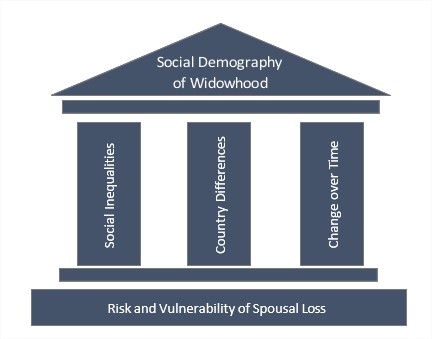Accueil>A Social Demography of Widowhood across Ageing Societies
04.09.2023
A Social Demography of Widowhood across Ageing Societies
The WIDOW Project (2023-2028)
A Social Demography of Widowhood across Ageing Societies
 The principle investigator is Zachary Van Winkle, Assistant Professor of Sociology at Sciences Po - CRIS.
The principle investigator is Zachary Van Winkle, Assistant Professor of Sociology at Sciences Po - CRIS.
Widowhood is a critical life event entailing profound grief and consequences in the short-term and long-term. It remains one of the prime life course risks in contemporary societies.
Most research demonstrates that spousal loss commonly may lead to an immediate decline in both mental health and economic wellbeing. In fact, existing evidence is mixed as to whether widows and widowers recover from grieving quickly or remain chronically and clinically depressed for years.
It is also unclear whether the financial consequences of spousal death are short lived or push large numbers of widows and widowers into a persistent state of old-age poverty.
As many countries grow older, the number of marriages ending with the death of a spouse is increasing dramatically, despite high separation rates. Although widowhood remains a common life event, many countries have cut or even abolished survivor benefit schemes targeted at securing the wellbeing of widows and widowers. The consequences of these reforms remain unknown.
Despite this social scientific research has been less interested in widowhood than other disruptive life events, such as job loss or divorce. The WIDOW project aims to remedy this.
This ground-breaking research will establish a social demography of widowhood. The foundation of this social demography is an innovative conceptual and methodological approach to estimate the risk of widowhood as well as the mental health and economic vulnerabilities of spousal loss. This research will concentrate on marital spousal loss among adults age 50 and older.
The risk of widowhood subsumes the probability of spousal loss and the duration of remaining widowed. The concept of vulnerability broadly denotes the consequences of widowhood during the pre- and post-widowhood periods for those who expect or not the loss of their spouse. Two types of outcomes are taking into account: mental health, including anxiety, insomnia, depression, and loneliness, as well as economic wellbeing, including household income, poverty, and wealth.
 Three pillars support that social demography.
Three pillars support that social demography.
The first assesses social inequalities in the risk and vulnerability to widowhood by focusing on how the probability and consequences of spousal loss vary by socioeconomic status, race-ethnicity, nativity, and networks of social support, as well as gender and age.
The second pillar zooms on cross-national differences in the risk and vulnerability to widowhood and their social inequalities. The geographic scope of this project spans middle- and high-income countries with ageing populations varying in demographic trends and welfare systems. The research will analyze all data sources from up to 60 countries.
The third pillar expands the comparative aspect of the project to examine both past and future change over time in the size and composition of the widowed population. Population changes will be assessed over time since 1989, with a projection to 2050.
